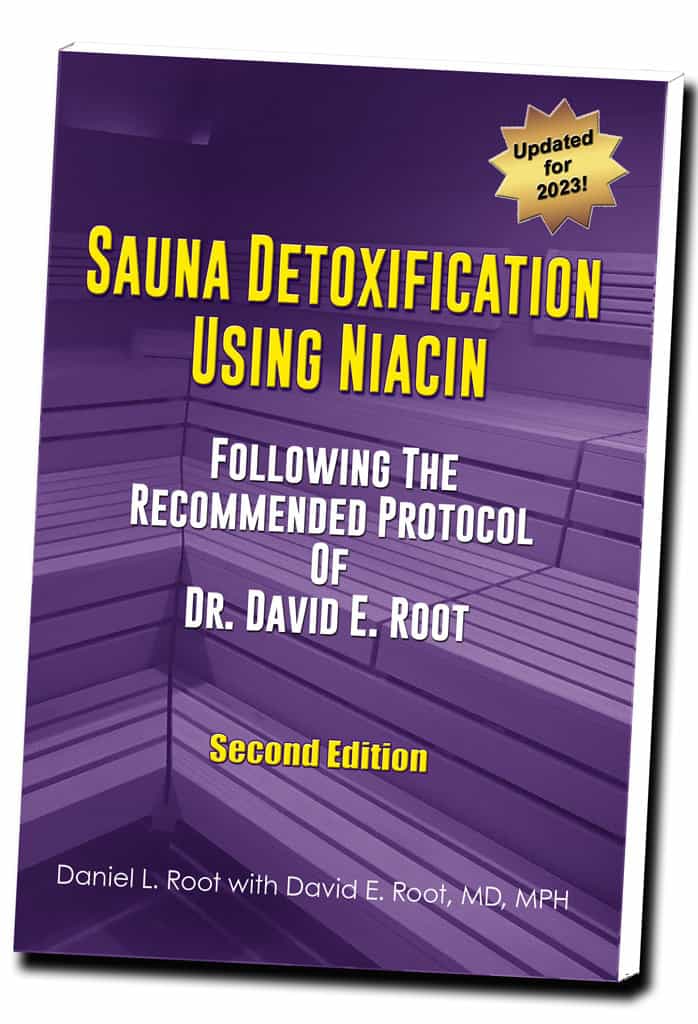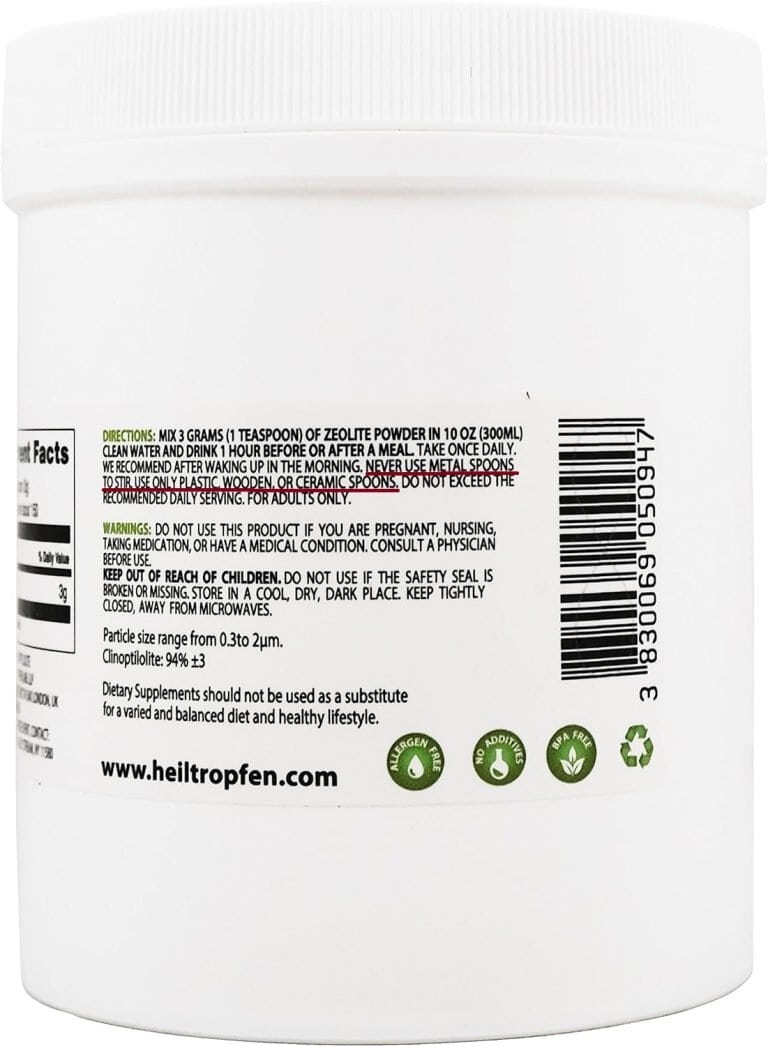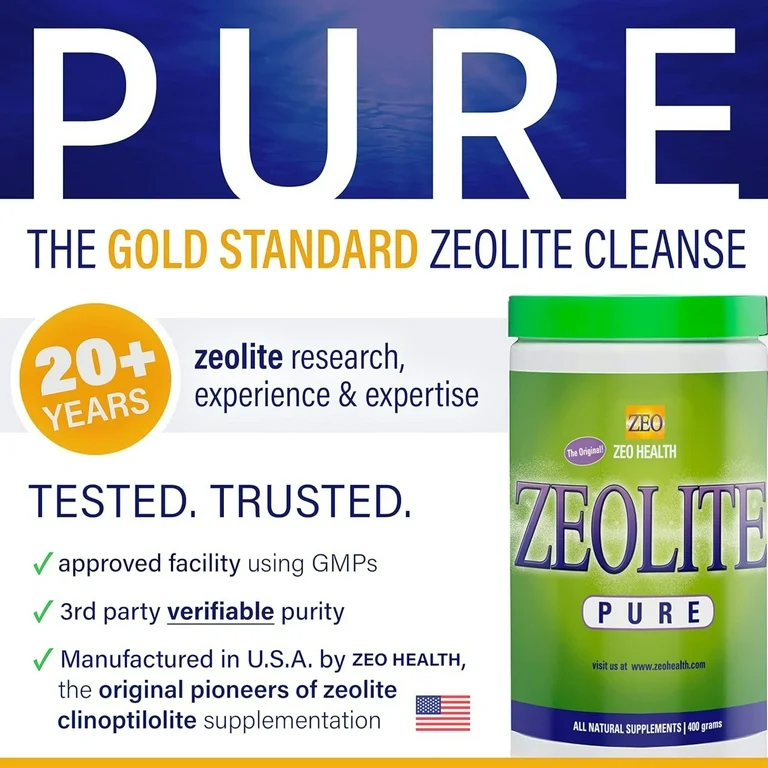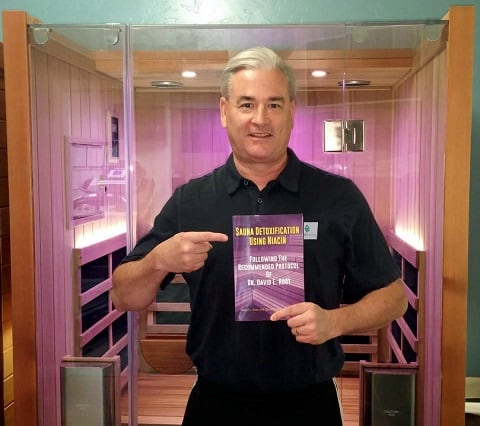Zeolite Clinoptilolite: Is it safe?
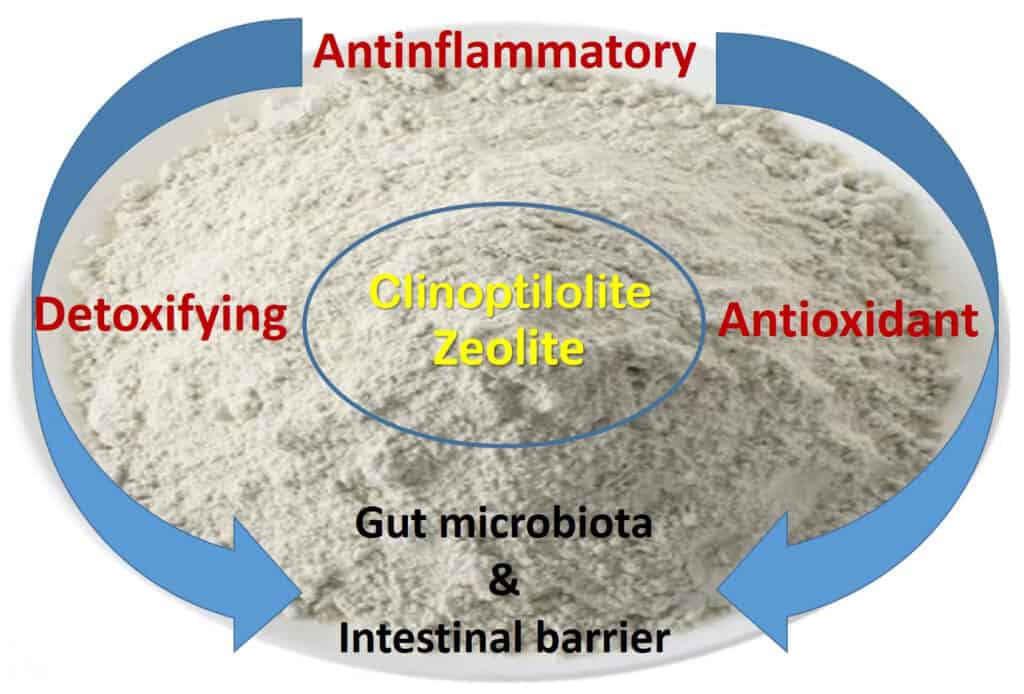
In the health world, the word “zeolite” is often wrapped in bold claims and vague science. Scroll through any detox forum or wellness marketing funnel, and you’ll find clinoptilolite zeolite touted as everything from a heavy metal magnet to a miracle powder capable of removing every toxin under the sun—just mix with water and wait for the magic. But when you ask how it works, what “purity” actually means, or how particle size affects where it goes in the body, you’ll find a lot of hand-waving—and not much clarity.
That’s where this article comes in.
Quick Navigation
Jump to a section that interests you most:
- What is zeolite clinoptilolite, anyway?
- Zeolite contains heavy metals; how is it safe then?
- What Are Magnets Attracting in Zeolite Videos?
- What Does It Mean When Manufacturers Provide the Purity Levels?
- Why Is Zeolite Used in Detox—Especially in Detoxination®?
- A Quick Primer: Adsorption, Absorption, and Ion Exchange
- Gadolinium Affinity (as a Special Note)
- Beyond the Gut: Systemic Potential
- Sidebar: Binder vs. Chelator—What’s the Difference?
- Can Zeolite Release the Bad Stuff?
- What Else Does Zeolite Do?
- Why Size Matters
- How to Properly Dose Zeolite
- What to Avoid When Taking Zeolite
- Why We Chose ZEO Health’s Zeolite Pure
This isn’t just another hype piece. It’s a grounded, science-forward explanation of what zeolite clinoptilolite really is, what it does, and how to use it safely and effectively—especially in the context of advanced detox protocols like Detoxination®.
We’ll unpack how zeolite is formed, what makes clinoptilolite special, and why its chemical structure matters more than most people realize. We’ll also take a closer look at what “purity” really means, why size absolutely matters, how bile acids fit into the detox puzzle, and what those viral videos with magnets are really showing. Along the way, we’ll dispel some of the biggest myths—like whether zeolite can leak toxins, or worse, deliver them.
Whether you’re a health practitioner, a detox enthusiast, or someone just trying to navigate the confusing world of natural binders, this guide will help you understand clinoptilolite zeolite the way you should’ve been taught from the start: without the fluff, and without the fear.
Let’s begin where all good detox discussions should: in the volcano.
What is zeolite clinoptilolite, anyway?
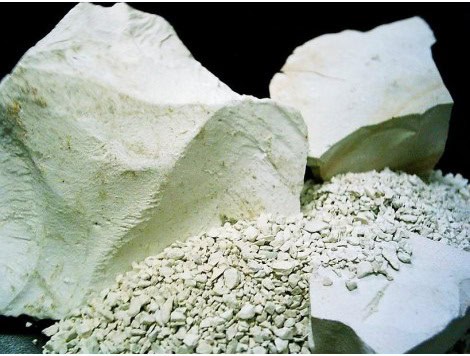
Zeolite isn’t a single mineral—it’s a family of crystalline, porous minerals formed when volcanic ash reacts with seawater or alkaline groundwater over thousands to millions of years. The result? A honeycomb-like structure made of aluminosilicate cages that carry a strong negative charge, giving zeolites their ability to trap positively charged ions (cations) like heavy metals, ammonium, and other toxins.
There are over 40 natural zeolites, but clinoptilolite is the one most studied—and most used—for human detoxification.1 It’s valued not only for its high cation exchange capacity, but also for its thermal and chemical stability in biological conditions.
Think of clinoptilolite as a naturally occurring molecular sieve. Its cage-like geometry acts like a smart filter: it doesn’t absorb water like a sponge—it selectively traps certain molecules while letting others pass through. This makes it a standout material not only in detox, but in agriculture, aquaculture, water purification, and even radioactive waste cleanup.
But here’s what sets clinoptilolite apart for human health:
- It doesn’t dissolve in the gut.
- It doesn’t break down in stomach acid.
- It doesn’t get absorbed into your cells.
- And, it doesn’t store in organs.2
Its action is mechanical and electrochemical—not metabolic. It binds. It holds. And it carries toxins out of the body—provided it’s the right size, in the right form, and taken at the right time. We’ll explore all of that in the sections to come.
Zeolite contains heavy metals; how is it safe then?
At first glance, the elemental makeup of clinoptilolite zeolite can sound alarming—especially when you see familiar red-flag words like aluminum, lead, arsenic, or even gadolinium in trace amounts. Some online critics, such as Dr. Richard Semelka, have pointed to laboratory findings of Gd in zeolite products and used that to suggest zeolite may introduce toxins rather than remove them.
Let’s unpack that with clarity.
Zeolite is a naturally occurring mineral formed from volcanic ash and seawater, and like any natural earth-based material, it may contain trace levels of various elements, including some we consider harmful in their free or ionic forms. But in clinoptilolite, these elements—including gadolinium—are not loose or bioavailable. They’re locked tightly into the crystalline matrix, part of the mineral’s structural backbone.
So let’s set the record straight on what these elements are doing in zeolite, and more importantly, what they’re not doing in your body.
🔹 Aluminum: Part of the Architecture, Not a Threat
Clinoptilolite is a naturally occurring aluminosilicate—meaning it’s built from aluminum and silicon tetrahedra arranged in a precise, stable crystalline matrix. This structure is what gives zeolite its negative charge, and therefore, its binding power. Aluminum isn’t an impurity—it’s part of the cage.
- It’s not free-floating.
- It’s not leachable in stomach acid.
- And it’s not bioavailable under any normal biological conditions.
To remove aluminum from zeolite, you’d need temperatures exceeding 400°C (752°F)—some sources say closer to 1000°F—far beyond what the human body can replicate.3
So when someone says “but zeolite has aluminum,” the correct answer is:
Exactly—and that’s what makes it work.
🔹 Gadolinium: Trace Detection, Not a Source of Exposure
More recently, concern has circulated in Gadolinium toxicity circles due to a blog post by Dr. Richard Semelka, who noted the presence of trace Gd in a zeolite sample. While accurate from an analytical standpoint, this has unfortunately led to confusion about whether zeolite products could add to gadolinium body burden.
The reality?
- Like many minerals, trace Gd may be present in naturally sourced zeolite.
- But like aluminum, it is tightly bound within the crystalline cage, not bioavailable, and not released in biological systems.
- Zeolite is far more likely to bind gadolinium from bile or interstitial fluids than contribute to it.
In fact, clinoptilolite’s use in oral contrast agents like Gado-Lite underscores its affinity for Gd—it holds onto it, not releases it.4
Bottom Line:
Don’t confuse the presence of elements with their availability.
Aluminum and gadolinium may show up in the elemental profile of zeolite—but they’re locked inside the mineral’s structure, not floating free. It’s the difference between a steel vault containing a toxin and a leaking barrel releasing one.
When properly sourced and processed, clinoptilolite binds toxins—it doesn’t deliver them.
What Are Magnets Attracting in Zeolite Videos?
It’s one of the most common “gotcha” moments in detox circles: a video showing a magnet drawing material toward the side of a glass containing zeolite mixed with water. To the untrained eye, it appears to be iron filings—or worse, proof that zeolite is contaminated or dangerous. But let’s break it down with science, not speculation.
Zeolite clinoptilolite, by itself, is not magnetic. It’s a stable, inert aluminosilicate mineral with no inherent attraction to magnetic fields. However, like most natural earth minerals, zeolite contains trace elements—including iron-based compounds such as magnetite (Fe₃O₄) and pyrrhotite (Fe₁₋ₓS). These naturally occurring iron oxides are weakly magnetic, and when suspended in water, they may be drawn toward a strong magnet.
This does not mean the zeolite is contaminated or harmful. In fact, these iron compounds are found in soil, clay, and even many foods we eat. The iron in magnetite and pyrrhotite is not in a soluble ionic form that would pose toxicity risk—and critically, these particles are too large to be absorbed systemically through the gut lining.
So what are those videos really showing? They’re highlighting the presence of trace, naturally magnetic minerals—not metallic iron or industrial contaminants. If anything, it’s a testament to zeolite’s authenticity as a mined, unadulterated natural substance.
There’s no cause for alarm. But there is a reason to understand the geology before drawing conclusions from a viral clip.
What Does It Mean When Manufacturers Provide the Purity Levels?
“Purity” might sound like a straightforward term, but in the world of zeolite, it’s often misunderstood—and sometimes deliberately misused.
When most consumers hear that a zeolite product is “90% pure,” they assume the other 10% must be contaminants—like dirt, toxins, or heavy metals. But that’s not how it works.
In zeolite manufacturing, “purity” refers to the percentage of clinoptilolite in the total mineral content. The remaining percentage usually consists of other natural zeolites like mordenite or phillipsite, or inert minerals like quartz or feldspar—not contaminants, but simply non-clinoptilolite material that was mined from the same deposit.
This matters because not all zeolites behave the same way. Clinoptilolite is prized for its cage structure, binding strength, and chemical stability in biological systems. Other zeolites may be more brittle, less selective, or more prone to breaking down under digestive conditions.
But What About “Purity from Toxins”?
Here’s where some marketing—especially in nano-zeolite MLM circles—gets slippery. These companies often conflate “purity” with having been cleansed of toxic metals. They boast about using proprietary chemical washes to remove “everything bad” from their product, implying that unwashed zeolite is toxic. Let’s be clear:- Clinoptilolite’s entire function is to hold onto metals.
- If it’s sourced from a clean deposit and processed correctly, there’s no need to “purify” it with aggressive chemical treatments.
- And even if trace elements like arsenic or lead are present within the structure, they are bound tightly and non-bioavailable.
Purity Doesn’t Mean What You Think
So if a company claims “99.9% purity,” ask:- “Purity of what?”
- “What exactly was removed—and how?”
- “What’s the actual percentage of clinoptilolite?”
Why Is Zeolite Used in Detox—Especially in Detoxination®?
Zeolite’s growing reputation in detox circles isn’t just hype—it’s grounded in real, measurable benefits.5 Thanks to its negatively charged, cage-like structure, clinoptilolite binds positively charged toxins, including heavy metals like lead and mercury, as well as ammonium, histamine, and other metabolic waste products. And unlike some binders, it doesn’t just absorb toxins—it traps them in a way that prevents re-release during digestion.
But perhaps zeolite’s most overlooked superpower lies in its role as a bile acid binder.
The Bile Connection
Ask most doctors how the body eliminates toxins, and you’ll likely hear some version of: “The liver detoxifies them, then sends the water-soluble ones to the kidneys, and the rest out through stool.” It sounds complete—but this common explanation leaves out a critical mechanism that may explain why so many people struggle to detox effectively, even while doing “all the right things.”
The truth is this: the liver doesn’t always detoxify toxins—it reroutes what it can’t break down. And for many man-made chemicals, mold mycotoxins, persistent organic pollutants, and heavy metals like mercury and gadolinium, that reroute is through bile.
When the Liver Can’t Break It Down, It Dumps It
While the liver can conjugate and excrete some compounds through urine, others—especially those that are lipophilic—are bound to bile acids and dumped into the small intestine.6 But here’s the part most practitioners miss: this isn’t always because the toxin has been neutralized. In many cases, the liver simply lacks the ability to metabolize these compounds into safer, water-soluble forms.
Instead, it packs them into bile and ships them out—not because they’re safe, but because they’re too dangerous to store and too difficult to neutralize.
Bile isn’t a one-way street. Over 90% of bile acids—and everything they carry—are reabsorbed at the end of the small intestine and cycled back through the liver. This loop, known as enterohepatic recirculation, becomes a toxic slipstream when fat-soluble toxins like persistent organic pollutants, mold mycotoxins, or heavy metals are caught in the mix.
Dr. Garrett Smith’s Toxic Bile Theory takes this further. He proposes that when the liver can’t enzymatically neutralize a xenobiotic, it binds it to bile and dumps it into the intestines—not because it’s safe, but because it’s the only available route. The problem? Unless those bile-bound toxins are intercepted in the gut, they’re simply reabsorbed, reprocessed, and recirculated—day after day.
This boomerang effect may be one of the most overlooked drivers of chronic toxicity, contributing to inflammation, cellular dysfunction, and even the rise in modern diseases like NAFLD and hormone disruption.
An Emerging Hypothesis: Is Toxic Bile Driving NAFLD?
Here’s where clinical observation meets biochemical logic. In clients following the Detoxination® protocol, we’ve repeatedly seen cases of Non-Alcoholic Fatty Liver Disease (NAFLD) reverse—without major dietary changes, weight loss, or medications.
Why?
Because zeolite, when timed correctly, appears to interrupt toxic bile recirculation, preventing the liver from reabsorbing what it worked hard to get rid of.
This raises a powerful hypothesis:
Could NAFLD be, in part, the liver’s protective response to chronic toxin reabsorption through bile?
In other words, maybe the liver isn’t just “getting fatty” from poor diet—it’s walling itself off from constant exposure to recirculated xenobiotics, endocrine disruptors, mold toxins, and metals like mercury or gadolinium. Over time, that protective burden may lead to fatty infiltration and mitochondrial dysfunction.
By capturing bile-bound toxins in the gut, zeolite could be relieving the liver’s burden, reducing oxidative stress, and allowing hepatocytes to return to metabolic balance.
The result?
— Less inflammation.
— Better fat metabolism.
— And in some cases, complete reversal of fatty liver pathology.
The Clinoptilolite Advantage: Why It’s Essential in Detoxination®
Zeolite’s value in detox isn’t just theoretical—it’s deeply practical, especially in protocols like Detoxination®, where niacin-induced rebound lipolysis mobilizes fat-stored toxins into circulation.
As these toxins move through the liver, many are conjugated and routed into bile, destined for the intestines. But as we’ve seen, unless bile-bound toxins are intercepted in the gut, they’re reabsorbed—and the liver’s efforts are undone.
That’s where clinoptilolite comes in.
Because it mostly stays in the gut and doesn’t get absorbed, zeolite acts like a toxin trap, binding bile-bound compounds on contact and preventing their reabsorption into circulation. This is critical for ensuring that mobilized toxins are eliminated, not redistributed—and it’s why we emphasize taking zeolite at regular intervals, especially after meals, when bile flow is highest.
In Detoxination®, we don’t just focus on liberating toxins from storage—we focus on capturing them at the exit.
A Quick Primer: Adsorption, Absorption, and Ion Exchange
If we’re going to talk intelligently about what zeolite does, it’s essential to understand a few key terms that often get tossed around interchangeably—but shouldn’t be.
You may have heard that zeolite “absorbs toxins.” That language shows up often—even among health professionals. And while it paints a helpful picture, it’s not technically correct.
Let’s set the record straight—with clarity, not criticism.
Absorption (The Common Misconception)
Absorption refers to substances being soaked into the body or a material’s internal volume—like water into a sponge. In biological terms, absorption means a compound is taken into tissues or cells.
Zeolite does not absorb toxins in this sense. It doesn’t swell, dissolve, or metabolically take anything in.
So why do people say it does?
Because zeolite’s crystalline structure can trap toxins inside—but not by soaking them up.
Adsorption (What Zeolite Actually Does)
This is zeolite’s real magic.
Adsorption means binding to a surface—and in the case of clinoptilolite, that surface includes:
- the outer crystal
- the internal pore walls
- and the negatively charged cages deep within its honeycomb-like lattice
In other words, toxins aren’t just sticking to the outside of the particle—they’re adsorbing to the internal surface area of its porous structure, which can be hundreds of square meters per gram.
This is how zeolite holds on to:
- Lead
- Mercury
- Ammonium
- Histamine
- Mycotoxins
- Even challenging elements like gadolinium (used in MRI contrast) and radioactive isotopes like cesium-137
Ion Exchange (The Intelligent Trap)
Inside zeolite’s crystalline cage are exchangeable cations—usually sodium, calcium, or magnesium. When zeolite encounters a stronger-binding ion—like lead or gadolinium—it releases the weaker ion and traps the toxic one inside its cage.
This process is:
- selective
- reversible under controlled conditions
- and stable under biological conditions
This is why zeolite continues working—even in a soup of competing toxins—because it can prioritize what it binds based on affinity and charge.
In Summary:
- Absorption = Soaking in (biological uptake, like food or water)
- Adsorption = Sticking to internal and external surfaces of a solid material
- Ion Exchange = Swapping safe minerals for toxic ones inside zeolite’s crystalline cages
So while it’s tempting to think of zeolite as “absorbing” toxins like a sponge, what it’s really doing is more like a high-tech mineral filter—adsorbing molecules across a vast internal surface and locking them in place through intelligent exchange.
With that foundation, let’s look at one of the most difficult-to-remove toxic elements zeolite may help with: gadolinium.
Gadolinium Affinity (as a Special Note)
Why Zeolite May Help
Clinoptilolite has a strong cation exchange capacity, particularly for multivalent ions like gadolinium (Gd³⁺). In fact, one MRI oral contrast product—Gado-Lite—uses zeolite to bind free gadolinium within the gastrointestinal tract, preventing it from being absorbed during GI imaging. This demonstrates that:- Zeolite is capable of binding gadolinium, at least within the digestive tract.
- It may be especially useful when gadolinium is routed into bile and excreted via the liver—a detox pathway that can be intercepted by gut-level binders.
Beyond the Gut: Systemic Potential
- Zeolite may also help chelate free gadolinium systemically, intercepting it before it deposits in tissues.
- When used alongside toxin-mobilizing protocols like Detoxination®, it may capture gadolinium both in bile and potentially in circulation.
Sidebar: Binder vs. Chelator—What’s the Difference?
Binders
Binders are physically stable substances—like zeolite, activated charcoal, or bentonite clay—that work exclusively in the GI tract. They trap toxins using surface attraction (adsorption) or ion exchange, especially bile-bound toxicants, and carry them out through stool. They do not enter the bloodstream and do not form chemical bonds with metals.Chelators
Chelators are circulating molecules that chemically bond with metals—usually through a claw-like structure that forms a tight ring around ions like mercury, lead, or gadolinium. These complexes are then filtered through the kidneys and excreted via urine. Examples include:- EDTA
- DMSA / DMPS
- Boyd Haley’s Emeramide (OSR/NBMI)
Zeolite: A Unique Middle Ground
Clinoptilolite is generally classified as a binder, because it remains in the gut and adsorbs toxins carried into the intestines (especially via bile). However, with particle sizes under 10 microns, as seen in ZEO Health’s Zeolite Pure, a portion of zeolite may:- Enter interstitial fluids
- Bind free metals in circulation
- Function as a gentler, surface-based chelator, without the redistribution risks of aggressive agents
Can Zeolite Release the Bad Stuff?
“If zeolite contains aluminum or other heavy metals from its natural formation, can it release those toxins back into the body?”The short answer? Not under normal biological conditions. Clinoptilolite’s structure is not like a loose sponge soaked with bad ingredients—it’s a highly stable, three-dimensional crystalline lattice that binds elements through strong electrostatic forces and ion exchange, not loose association. The metals it may contain (like aluminum or trace gadolinium from natural geology) are tightly locked into its molecular framework. In fact, clinoptilolite is so stable that it requires extreme conditions to break apart—temperatures of 400°C to 750°C (750°F to 1,400°F) are needed to start disrupting its lattice.3 That’s far beyond anything encountered in digestion, sauna use, or everyday life.
What About Stomach Acid?
Some online “hit pieces” claim that stomach acid (HCl) can break down zeolite and cause it to leach metals. But this simply doesn’t hold up—either chemically or in real-world applications.7 Let’s look at the case of Gado-Lite, an oral zeolite-based MRI contrast agent used in preclinical studies to bind gadolinium.- It’s taken orally, directly entering the stomach’s acidic environment.
- If hydrochloric acid (pH ~1.5–3.5) could break down clinoptilolite, we would expect free gadolinium to be released and absorbed.
- But animal studies show zero systemic retention of gadolinium—meaning the zeolite remained intact, did not dissolve, and effectively carried the gadolinium out through feces.8
The Bottom Line:
Zeolite clinoptilolite is not a leaky cage. It’s a highly stable, selective molecular trap. The toxins it captures—whether bile-bound, interstitial, or dietary—remain bound until safely eliminated. In Detoxination®, this stability is key. Clients undergo intense toxin mobilization through rebound lipolysis, sauna heat stress, and bile dumping. Zeolite provides the fail-safe: a constant gut-level presence to ensure that what gets mobilized doesn’t get reabsorbed.What Else Does Zeolite Do?
1. Improves Gut Barrier Function
Clinoptilolite has been shown in animal studies to reduce intestinal permeability—commonly referred to as “leaky gut.” By reinforcing tight junctions and acting as a molecular sieve, it may prevent unwanted particles, microbial toxins, or food antigens from entering the bloodstream. This gut barrier support may help reduce low-grade inflammation and improve immune tolerance, especially in those with environmental sensitivities or autoimmune conditions.2. Enhances Nutrient Absorption
While zeolite doesn’t absorb nutrients itself, it creates a cleaner, more efficient intestinal environment by removing competitive inhibitors like ammonium, histamine, or microbial toxins. Some studies have shown:9- Longer villi in the intestines
- Improved surface area for nutrient uptake
- Better digestive efficiency, especially when chronic endotoxemia or dysbiosis is present
3. Reduces Inflammatory Load
By capturing pro-inflammatory compounds like histamine, ammonium, and lipopolysaccharides (LPS), clinoptilolite can help reduce systemic inflammation—a key driver behind many chronic conditions. In Detoxination®, this may translate into:- Less Herxheimer-like detox reactivity
- Calmer skin and joint responses
- More stable mood and energy during toxin mobilization
4. Modulates the Microbiome (Speculative, But Promising)
Preliminary studies suggest that zeolite may support a healthier microbial balance—not by acting as a direct antimicrobial, but by altering the terrain:- Reducing toxins that feed dysbiosis
- Adsorbing ammonia and metabolic byproducts
- Supporting pH balance and reducing gut stress
In Summary
Zeolite clinoptilolite isn’t just a detox workhorse—it’s a gut ally, an immune modulator, and possibly even a nutrient optimization tool. When used as part of a comprehensive protocol like Detoxination®, it supports not just toxin elimination, but tissue repair, recovery, and resilience.Why Size Matters
When it comes to zeolite, particle size isn’t just a technical detail—it determines where the zeolite operates in the body, how long it stays there, and whether it remains in the gut or potentially enters circulation.
Unfortunately, this is also where a lot of confusion and marketing hype begins, especially from MLMs selling nano-sized or “liquid” zeolite products. Let’s cut through the noise and clarify what the science—and real-world observation—actually shows.
The Basics of Particle Size
- >10 microns: Too large to cross the intestinal barrier. These particles remain entirely in the GI tract, binding bile-carried toxins, histamine, and other gut-level waste before being eliminated in stool.
- <10 microns: Small enough to potentially pass through tight junctions in the gut wall, especially during digestion. These may access interstitial fluids, where they could interact with circulating toxins—though the majority still remains in the gut.
- <1 micron (nano-sized): These particles are often marketed for their ability to penetrate deeper into tissues and even enter cells. However, there is no established elimination pathway for them once they go inter-cellular—raising questions about long-term tissue accumulation and safety.
This is where ZEO Health’s Zeolite Pure strikes a strategic balance.
According to company founder Micah Portney:
- 70–80% of particles are 10 microns or less, which optimizes binding surface area while allowing some limited systemic potential.
- 20–30% are larger particles (up to 40 microns), which stay entirely within the gut for 6–8 hours, offering sustained bile toxin interception.
Why This Balance Matters
Some products promote ultra-small particle sizes under the assumption that smaller means more effective—and MLM companies in particular often boast that their nano-zeolites are “small enough to enter your cells.”
But that raises a serious question:
If a zeolite particle enters a cell, how does it get back out?
Clinoptilolite is not metabolized or broken down by the body. And unlike chemical chelators that circulate and clear through the kidneys, zeolite has no known cellular exit pathway. That means particles—and the toxins they carry—could remain trapped in sensitive tissues, with unknown long-term consequences.
This is not just a theoretical concern. To date, there’s no peer-reviewed evidence showing that submicron or nano-zeolites:
- Leave the cell after entry
- Are safely excreted from the body
- Provide better detox outcomes than larger-particle alternatives
In contrast, ZEO Health’s Zeolite Pure was not designed to penetrate cells. Its purpose is to act in:
- The GI tract, where it binds bile-released toxins
- The interstitial fluids, where it may help intercept toxins mobilized from tissue
- And possibly the bloodstream, without crossing into intracellular spaces
This makes it far better aligned with safe, systemic detox—without introducing the risk of cellular accumulation.
Visualizing the Difference
Here’s a practical way to think about it:
| Particle Size | Location of Action | Role | Exit Path |
|---|---|---|---|
| >10 microns | GI tract only | Binds bile toxins | Feces |
| <10 microns | Some may enter system | May bind circulating toxins | Mostly feces; some urine |
| <1 micron | Enters cells | Unknown safety profile | Uncertain—no proven exit route |
During our conversation, Micah Portney emphasized a key point that’s often misunderstood: zeolite clinoptilolite doesn’t need to enter cells to support detoxification. Its strong negative charge acts like a magnet, attracting positively charged toxins from the surrounding fluid—including those stored inside cells. This ionic pull can help draw toxins out of cells into the extracellular space, where zeolite is waiting to bind them. In this way, clinoptilolite can participate in detoxification at the systemic level—without crossing the cell membrane or needing to become nano-sized. It’s a simple but powerful mechanism that stands in contrast to claims that zeolite must go intracellular to be effective.
In Summary
Zeolite isn’t a one-size-fits-all supplement. The goal is not maximum absorption, but targeted action with safe elimination. In Detoxination®, we use zeolite primarily to capture toxins in the GI tract—but by choosing a product with mixed particle sizes, like Zeolite Pure, we may also support limited systemic detox—without the risks of going too small.
How to Properly Dose Zeolite
Why Taking Too Little Is Problematic
In the world of detox, more is not always better—but too little is almost always ineffective. This is especially true when it comes to binders like zeolite.
Many people begin detoxification with the intention of removing stored toxins—whether environmental pollutants, heavy metals, or mold-derived compounds—but fail to appreciate what happens after those toxins are mobilized. Once in circulation, the body reroutes many of them into bile. Without enough zeolite present in the intestines to intercept them, those toxins can recirculate, reabsorb, and redeposit in tissues—often in more sensitive places like the brain, nerves, or joints.
This phenomenon, known as toxic redistribution, is one of the most overlooked and misunderstood challenges in detox. And in many cases, it’s not due to “detox being too intense”—it’s because there wasn’t enough binder present to safely escort toxins out.
Why This Is Especially Important in Detoxination®
Detoxination is a mobilization-heavy protocol. With rebound lipolysis triggered by niacin, toxins that may have been dormant for years are pulled into circulation. The protocol is designed to then direct those toxins toward bile and sweat—but if the bile pathway isn’t supported by sufficient zeolite, you’re relying on chance, not physiology.
This is why we emphasize multiple zeolite doses per day. Once in bile, the toxins are in motion—and if they aren’t captured, they’re coming back around again.
The Target Dose
Most capsule-based zeolite supplements fall short—typically delivering just 400 to 800 mg per serving, which may be inadequate to bind a meaningful load of bile-carried or circulating toxins.
Research and clinical observation suggest that 3 to 5 grams per dose is a more effective range—especially during active detoxification.
ZEO Health’s Zeolite Pure is formulated for this kind of serious application. Based on its particle size and residence time in the gut (6–8 hours), Micah Portney recommends:
- 5 grams per dose, taken up to three times daily
- This equates to roughly 1 rounded tablespoon, though due to zeolite’s light density, measuring by weight is most accurate
For those following the Detoxination® protocol, we typically recommend 1 level teaspoon (~3 grams) taken four to five times per day. This staggered approach helps ensure that bile-bound toxins—liberated throughout the day after niacin-triggered rebound lipolysis—have a binder in place to intercept them in the GI tract.
Either strategy works—what matters most is consistency and sufficient quantity to match the body’s detox activity.
Timing is Critical
Zeolite is most effective after bile has been released into the small intestine—which happens in response to fat-containing meals. For optimal effect:
- Take zeolite 30 to 60 minutes after meals (especially fatty ones)
- Space doses every 3 to 4 hours to maintain consistent binding coverage
- On sauna days, take zeolite after the second sauna cycle, when toxin mobilization is peaking
Underdosing and Redistribution
Taking too little zeolite during active detoxification can be counterproductive. When toxins are mobilized—whether through niacin, exercise, sauna, or chelators—they often enter bile for elimination. If no binder is present to intercept them, those toxins can reabsorb into the bloodstream, a process known as enterohepatic recirculation.
This not only reduces detox efficacy, but can increase symptoms or cause redistribution into more sensitive tissues.
Is There a Maximum Dose?
To date, no upper limit has been established for natural zeolite clinoptilolite. Studies have used very high doses without adverse effects, especially when the zeolite is purified and tested for safety, as with Zeolite Pure.
Still, it’s important to build up gradually in those with high toxic loads, MCAS, or sensitive gut conditions. Starting with smaller doses and working up to the full protocol is often best tolerated.
The goal is not to take more than necessary—but to ensure you’re taking enough to match your level of mobilization. In this context, five teaspoons of Zeolite Pure per day is not excessive—it’s foundational.
What I Got Wrong About Metal Spoons
When I was first introduced to the CEO of Heiltropfen, Tomaz Stanovnik, he warned against using metal spoons—an idea that stuck with me over the years. However, Micah corrected this misconception. According to Micah, using a stainless steel spoon is perfectly safe. Zeolite doesn’t interact with metal utensils in any meaningful way unless the metal itself is breaking down (as in the case of a corroding or contaminated spoon). He himself uses stainless steel when mixing his own product, and emphasized that the brief contact time and durability of modern silverware pose no risk. This is a great example of how well-meaning but unverified practices can get passed along—sometimes even ending up on product labels.
According to Micah , clinoptilolite zeolite doesn’t strip the body of beneficial minerals. That’s because ions like calcium, potassium, and magnesium aren’t part of the zeolite’s fixed crystalline structure—they’re loosely held via ionic attraction inside its cage-like framework. These “placeholder” cations are only released through the process called cation exchange, which occurs when zeolite encounters a contaminant with a stronger positive charge—like lead or mercury. As Micah puts it, “It’s not going to swap a hamburger for another hamburger—it holds out for filet mignon.” In other words, zeolite saves its binding power for the bad stuff.
What to Avoid When Taking Zeolite
Zeolite clinoptilolite is one of the safest and most targeted binders available—but how you take it can greatly impact its effectiveness. After speaking with Micah Portney, founder of ZEO Health, I gained a clearer understanding of why timing—especially around supplements and certain materials—matters more than I previously emphasized.
Here’s what to avoid to get the most from your zeolite—and why:
1. Taking It Too Close to Supplements or Medications
Zeolite works through adsorption and ion exchange, meaning it binds positively charged particles—including heavy metals, histamine, and ammonium—in the gut.
But according to Micah, if you take it too close to charged minerals or therapeutic compounds, the zeolite may bind those nutrients instead of your intended toxins. This doesn’t mean it’s harmful—it just means it’s now “occupied,” and can no longer carry the toxic load you mobilized through sauna, exercise, or niacin.
Especially susceptible nutrients include:
- Zinc, copper, iron, selenium
- Chelated minerals
- Some amino acids and electrolytes
- Medications, especially those with ionic or metallic components
Micah’s recommendation (which we now follow):
- Take zeolite at least 1 hour after supplements or medications
- Or wait 2 hours before your next dose
This simple timing buffer ensures your nutrients are absorbed—and your zeolite is ready to intercept the right targets.
2. Overlapping with Active Chelation Therapy
If you’re currently working with a practitioner on a chelating protocol (DMSA, DMPS, EDTA, or IV chelation), know that zeolite can interfere with chelators if taken too closely together.
In most cases, it’s best to use zeolite:
- After a chelation round, to mop up bile-bound toxins
- With protocols like Detoxination®, where its timing is already structured for compatibility
Why We Chose ZEO Health’s Zeolite Pure
After years of studying, using, and recommending various brands of zeolite—some of which worked well, others that raised concerns—I’ve now fully aligned with a product that meets the gold standard for safety, efficacy, and formulation:
ZEO Health’s Zeolite Pure.
Why ZEO Health?
Micah Portney, founder of ZEO Health, isn’t just another supplement manufacturer—he’s the pioneer who introduced zeolite clinoptilolite as a detoxification agent for human use in the U.S.
Long before zeolite was trendy—or distorted by MLM hype—Micah recognized its potential, invested in the testing, and developed formulations that respected both particle science and toxicology.
- Uses natural clinoptilolite purified through a proprietary process
- Maintains a balanced particle size distribution (0–40 microns, avg. 24)
- Stays mostly in the GI tract, with enough <10 micron material to access interstitial fluids
- Is third-party tested, free of contaminants, and backed by decades of real-world use
Why We Switched
I originally recommended Heiltropfen’s submicron zeolite based on surface area and binding potential. But after revisiting the science—and speaking directly with Micah—I’ve changed course. My greatest concern was always: How do particles that enter the cells exit the body? With nano-sized particles, there’s no clear answer. With Zeolite Pure, we now have a product that:- Supports bile and gut-level detox
- May assist in binding systemic toxins like gadolinium in extracellular fluids
- And most importantly—exits the body predictably, without concern for cellular accumulation
Final Thought
If you’re actively detoxing—whether through Detoxination or just cleaning up your system—don’t leave the exit door unguarded. Zeolite is your toxin trap, your mop, your molecular gatekeeper. And ZEO Health’s Zeolite Pure is, in my view, the best tool for the job.References
[1] Zeolite Clinoptilolite: Therapeutic Virtues of an Ancient Mineral
https://www.ncbi.nlm.nih.gov/pmc/articles/PMC6515299/
[2] The Impact of Long-Term Clinoptilolite Administration on the Concentration Profile of Metals in Rodent Organisms
https://pmc.ncbi.nlm.nih.gov/articles/PMC9952783/
[3] Thermal Behavior of Clinoptilolite
https://www.mdpi.com/2073-4352/14/7/646
[4] Gadolinium zeolite as an oral contrast agent for magnetic resonance imaging
https://pubmed.ncbi.nlm.nih.gov/8574032/
[5] Critical Review on Zeolite Clinoptilolite Safety and Medical Applications
https://www.ncbi.nlm.nih.gov/pmc/articles/PMC6277462/
[6] Biliary excretion of drugs and other xenobiotics
https://pubmed.ncbi.nlm.nih.gov/348071/
[7] Investigation of structural properties of clinoptilolite rich zeolites in simulated digestion conditions and their cytotoxicity against Caco-2 cells in vitro
https://link.springer.com/article/10.1007/s10934-012-9602-1
[8] Gadolinium zeolite as an oral contrast agent for magnetic resonance imaging
https://pubmed.ncbi.nlm.nih.gov/8574032/
[9] Using Natural Zeolite as a Feed Additive in Broilers’ Diets for Enhancing Growth Performance, Carcass Characteristics, and Meat Quality Traits
https://www.mdpi.com/2075-1729/13/7/1548
Daniel Root is the leading expert, practitioner, and trainer of Detoxination®. He is the son of the world renowned expert in human detoxification of heavy metals, synthetic/man-made chemicals, and radiation, Dr. David E. Root.
Dan and his father authored Sauna Detoxification Using Niacin that sells thousands of copies worldwide.
He was co-host of a weekly radio program, The Get Detoxinated! Show on KSAC 105.5 FM.
Dan is the CEO of Detoxination Wellness Centers, a dba of Sabre Hawk, LLC.
He has been an entrepreneur in the Information Technology field since 1989, and is the adoptive father of 3 biological sisters.
Dan served on the Board of Sierra Adoption Services for 6 years. He lives with his wife, Suzy, and their youngest daughter in Sacramento, California.
 Click here to learn more about our Testimonials and Results Disclaimer
Click here to learn more about our Testimonials and Results Disclaimer
Disclaimer: Information on this web site is provided for informational purposes only. The information is a result of years of practice experience by the authors. This information is not intended as a substitute for the advice provided by your physician or other healthcare professional or any information contained on or in any product label or packaging. Do not use the information on this web site for diagnosing or treating a health problem or disease, or prescribing medication or other treatment. Always speak with your physician or other healthcare professional before taking any medication or nutritional, herbal or homeopathic supplement, or using any treatment for a health problem. If you have or suspect that you have a medical problem, contact your health care provider promptly. Do not disregard professional medical advice or delay in seeking professional advice because of something you have read on this web site. Information provided on this web site and the use of any products or services purchased from our web site by you DOES NOT create a doctor-patient relationship between you and any of the physicians affiliated with our web site. Information and statements regarding dietary supplements have not been evaluated by the Food and Drug Administration and are not intended to diagnose, treat, cure, or prevent any disease.
